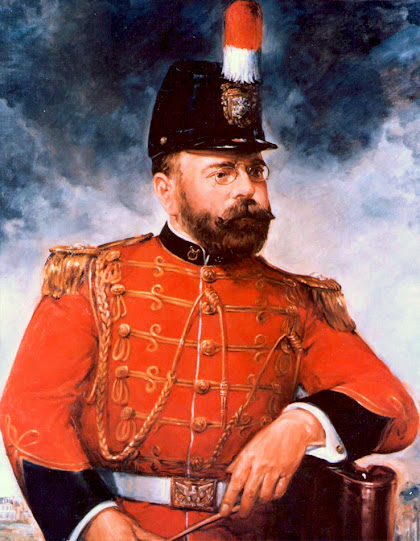John Philip Sousa, already an accomplished violinist at age 13, intended to join a traveling circus band in 1868.
But when his father, Antonio Sousa, got wind of his son’s plan, he pulled a few strings, and got the boy “enlisted” to serve as an apprentice musician with the United States Marine Band in Washington, D.C.
Antonio was a talented instrumentalist
himself. Born in Spain, he and his wife, Marie Elisabeth Trinkhaus Sousa, had
moved to the United States in 1854. Antonio joined the Marine Band that same
year as a trombonist.
John Philip Sousa remained in the band to complete his eight-year hitch, moving on in his early 20s to become an independent composer and arranger. Somewhat out of the blue, he was offered an opportunity to return to the Marine Band in 1880 as its director. He agreed to become leader of the band at age 26.
There were skeptics who questioned whether young John Philip Sousa had the mettle. He did have The Washington Post in his corner. Its editorial on Oct. 2, 1880, proclaimed that Sousa “is well and favorably known by a large class of our best citizens and all doubts as to his capabilities on the score of youth or inexperience may be dismissed, as persons capable of judging will soon learn for themselves.”
The Marine Band remained
a Sousa family tradition. Antonio had retired from the band in 1879, but another
Sousa had joined. George, a younger brother of John Philip, had started as an
apprentice musician in 1877, as a percussionist.
John Philip Sousa went on to shape his musicians into the country’s premier military band. He was best known for composing military marches, with tempos that match the pace of soldiers walking in step, at the rate of about 120 beats per minute. This genre usually features “a strong and steady percussive beat reminiscent of military field drums.”
Sousa’s “The Stars and Stripes Forever” (1896) is “the official National March of the United States of America.”
Under Sousa the Marine Band also made its first recordings. The phonograph was a relatively new invention, and the Columbia Phonograph Company sought an ensemble to record. The Marine Band was chosen, and 60 cylinders were released in the fall of 1890…and the musicians became “rock stars.”
The immense popularity of the Marine Band made Sousa eager to take his Marine Band on tour.
He once said: “My years in Washington had taught me that if you wanted to see the president, you saw his wife first! So, I asked to see Mrs. Harrison.”
Caroline Lavinia Scott Harrison, a music teacher, liked the idea and agreed to speak to her president husband, Benjamin Harrison.
Sousa continued his story: “The next morning, I was summoned by the president, who commented, ‘Mrs. Harrison tells me that you are anxious to take the Marine Band on tour, and even though I was thinking of taking my own tour, l believe the country would rather hear you than see me! Permission is thereby granted.’”
The 1891 tour involved 32 cities across New England and the Midwest, setting the pattern of regional tours that is still followed today. Each stop included matinee and evening concerts with totally different musical programs. The 1892 tour took the band to the Pacific Coast and 37 towns.
John Philip Sousa had
gained fame but not fortune as a government employee. He decided to resign from
the Marine Band in 1892, move to Chicago and form a professional band.






.jpg)

No comments:
Post a Comment